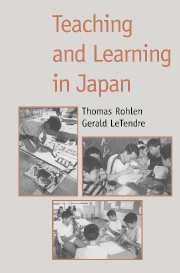Book contents
- Frontmatter
- Contents
- List of contributors
- Introduction: Japanese theories of learning
- Section I Fundamental approaches
- Section II The emotional foundations of early learning
- Section III School and classroom models
- Teachers and teaching: elementary schools in Japan and the United States
- Responsibility and learning: some preliminary hypotheses about Japanese elementary classrooms
- Cultures of mathematics instruction in Japanese and American elementary classrooms
- The Kumon approach to teaching and learning
- Section IV Path and guidance
- Section V Artistic pursuits – old and new
- Conclusion: themes in the Japanese culture of learning
- References
- Index
Responsibility and learning: some preliminary hypotheses about Japanese elementary classrooms
Published online by Cambridge University Press: 05 June 2012
- Frontmatter
- Contents
- List of contributors
- Introduction: Japanese theories of learning
- Section I Fundamental approaches
- Section II The emotional foundations of early learning
- Section III School and classroom models
- Teachers and teaching: elementary schools in Japan and the United States
- Responsibility and learning: some preliminary hypotheses about Japanese elementary classrooms
- Cultures of mathematics instruction in Japanese and American elementary classrooms
- The Kumon approach to teaching and learning
- Section IV Path and guidance
- Section V Artistic pursuits – old and new
- Conclusion: themes in the Japanese culture of learning
- References
- Index
Summary
Academic achievement differences between U.S. and Japanese students have commanded great attention in recent years. Yet, we know relatively little about actual classroom instruction in the two countries. Recently, we coded ioo videotapes of lessons from U.S. and Japanese fourth-grade classrooms, using systems that focus on teachers' motivational and instructional strategies. In the course of coding the videotapes, we were struck by several apparent differences between the Japanese and U.S. classes that are not well captured by our coding system and that seem to merit further investigation.
This essay discusses two issues that struck us as we coded the videotapes of Japanese and U.S. classes: student responsibility for learning and for classroom management. By “student responsibility for learning,” we mean the extent to which students actively shape their learning environment by engaging in hands-on learning and active discussion; helping to shape the content and direction of lessons; and actively monitoring and directing their own learning. By “student responsibility for classroom management,” we mean student involvement in helping to shape and enforce the norms, rules, and practices needed to keep the classroom running smoothly.
Description of the sample
Our study was conducted in ten Japanese and ten U.S. fourthgrade classrooms. Japanese classrooms were all located within the Kasugai School District, near the city of Nagoya (population: 2 million). Kasugai is a middle-class suburb on the outskirts of Nagoya, with a population of about 260,000. Many residents of Kasugai commute to Nagoya, and others work locally in small- to medium-sized businesses.
- Type
- Chapter
- Information
- Teaching and Learning in Japan , pp. 190 - 212Publisher: Cambridge University PressPrint publication year: 1996
- 8
- Cited by



